The Belgi Market Hardens
Page 56
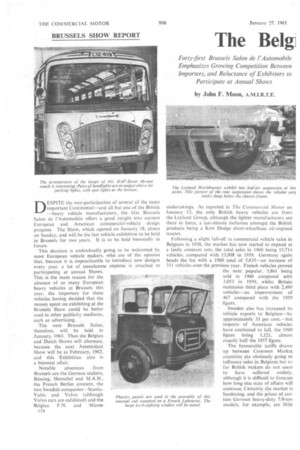
Page 57
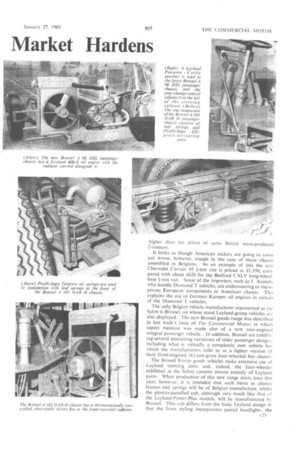
Page 58
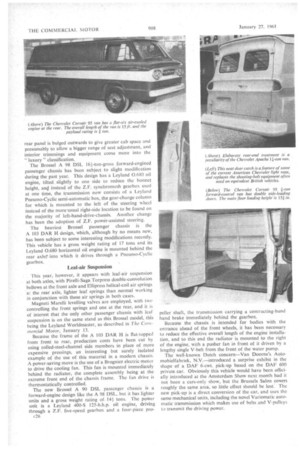
Page 59
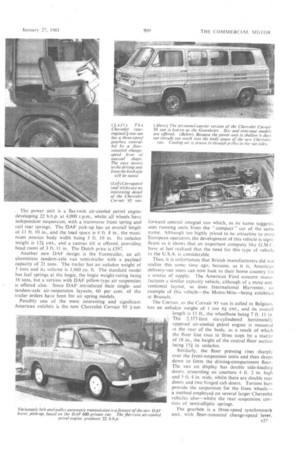
Page 60
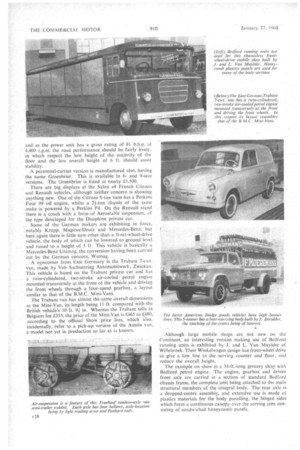
If you've noticed an error in this article please click here to report it so we can fix it.
Forty-first Brussels Salon de l'Autornobik Emphasizes Growing Competition Between Importers, and Reluctance of Exhibitors to Participate at Annual Shows
by John F. Moon, A.M.I.R.T.E.
DESP1TE the non-participation of several of the more important Continental—and all but one of the British —heavy vehicle manufacturers, the 41st Brussels Salon de l'Automobile offers a good insight into current
European and American commercial-vehicle design progress. The Show, which opened on January 18, closes on Sunday, and will be the last vehicle exhibition to be held in Brussels for two years. It is to be held biennially in future.
This decision is undoubtedly going to be welcomed by most European vehicle makers, who are of the opinion The next Brussels Salon, therefore, will be held in January, 1963. Thus the Belgian and Dutch Shows will alternate, because the next Amsterdam Show will be in February, 1962, and this Exhibition also is a biennial affair.
Notable absentees from Brussels are the German makers, Bussing, Henschel and M.A.N.. the French Berliet concern, the two Swedish companies—ScaniaVabis and Volvo (although Volvo cars are exhibited) and the Belgian F.N. and Miesse r24
The Leyland Worldmaster exhibit has leaf-air suspension at bat axles. This picture of the rear suspension shows the tubular sure tanks slung below the chassis frame. undertakings. As reported in The Commercial Motor on January 13, the only British heavy vehicles are from the Leyland Group, although the lighter manufacturers are there in force, a last-minute inclusion amongst the British products being a Kew Dodge short-wheelbase oil-engined tractor.
Following a slight fall-off in commercial vehicle sales in Belgium in 1958, the market has now started to expand at a fairly constant rate, the total sales in 1960 being 15,714 vehicles, compared with 13,908 in 1959. Germany again heads the list with a 1960 total of 5,835—an increase of 311 vehicles over the previous year. French vehicles proved the next popular, 3,861 being sold in 1960 compared with 3,053 in 1959,. whilst Britain maintains third place with 2,490 vehicles—an improvement of 467 compared with the 1959 figure.
Sweden also has increased its vehicle exports to Belgium—by approximately 33 per cent.—hut imports of American vehicles have continued to fall, the 1960 figure being 1,121, almost exactly halfthe 1957 figure.
The favourable tariffs drawn up .between Common Market countries are obviously going to influence sales in Belgium but so far British makers do not seem to have suffered unduly. although it is difficult to forecast how long this state of affairs will continue. Certainly the market is hardening, and the prices of certain German heavy-duty 7/8-ton models, for example, are little
higher than the prices of some British mass-produced 7-tormers.
It looks as though American makers are going to come out worse, however, except in the case of those chassis assembled in Belgium. As an example of this the new Chevrolet Corvair 95 1-ton van is priced at £1,350, compared with about £620 for the Bedford CALV long-wheelbase i--ton van. Some of the importers, such as J. Avonds, who handle Diamond T vehicles, are endeavouring to incorporate European components in American chassis. This explains the use of German Kamper oil engines in certain of the Diamond T vehicles.
The only Belgian vehicle manufacturer represented at the Salon is Brossel, on whose stand Leyland-group vehicles are also displayed. The new Brossel goods range was described in last week's issue of The Commercial Motor, in which report mention was made also of a new rear-engined integral passenger vehicle, In addition, Brossel are exhibiting several interesting variations of older passenger designs. including what is virtually a completely new vehicle but which the manufacturers refer to as a lighter version of their front-engined 164-ton-gross four-wheeled bus chassis.
The Brossel Europ goods vehicles make extensive use of Leyland running units and, indeed, the four-wheeler exhibited at the Salon consists almost entirely of Leyland parts. When production of this new range starts later this year; however, it is intended that such items as chassis frames and springs will be of Belgian manufacture, whilst the plastics-panelled cab, although very much like that of the Leyland-Power-Plus models, will be manufactured by Brossel. This cab differs from the basic Leyland design in that the front styling incorporates paired headlights, the
rear panel is bulged outwards to give greater cab space and presumably to allow a bigger range of seat adjustment, and interior trimmings and equipment come more into the " luxury " classification.
The Brossel A 98 DSL 16f-ton-gross forward-engined passenger chassis has been subject to slight modification during the past year. This design has a Leyland 0.680 oil engine, tilted. slightly to one side to reduce the bonnet height, an instead of the Z.F. synchromesh gearbox used at one time, the transmission now consists of a Leyland Pneumo-Cyclic semi-automatic box, the gear-change column for which is mounted to the left of the steering wheel instead of the more -usual right-side location to be found on the majority of left-hand-drive-chassis. Another change has been the adoption of Z.F. power-assisted steering.
The heaviest Brossel passenger chassis is the A 103 DAR H design, which, although by no means new, has been subject to some interesting modifications recently. This vehicle has a gross weight rating of 17 tons and its Leyland 0.680 horizontal oil engine is mounted behind the rear axle!' into which it drives through a Pneumo-Cyclic gearbox.
Leaf-air Suspension
This year, however, it appears with leaf-air suspension at both axles, with Pirelli-Saga Torpress double-convolution bellows at the front axle and Ellipress helical-coil air springs at the rear axle, lighter leaf springs than normal working in conjunction with these air springs in both cases.
Magneti Marelli levelling valves are employed, with two controlling the front springs and one at the rear, and it is of interest that the only other passenger chassis with leaf suspension is on the same stand as this Brossel model, this being the Leyland Worldmaster, as described in The Commercial Motor, January 13.
Because the frame of the A 103 DAR H is flat-topped from front to rear, production costs have been cut by using rolled-steel-channel side members in place of more expensive pressings, an interesting but surely isolated example of the use of this material in a modern chassis. A power-saving move is the use of a Brogniez electric motor to drive the cooling fan. This fan is mounted immediately behind the radiator, the complete assembly being at the extreme front end of the chassis frame. The fan drive is thermostatically controlled.
The new Brossel A 90 DSL passenger chassis is a forward-engine design like the A 98 DSL, but it has lighter units and a gross weight rating of141 tons. The power unit is a Leyland 400-S 125-b.h.p. oil engine, driving through a Z.F. five-speed gearbox and a four-piece pro c26 peller shaft, the transmission carrying a contracting-band hand brake immediately behind the gearbox.
Because the chassis is intended for bodies with the entrance ahead of the front wheels, it has been necessary to reduce the effective overall length of the engine installation, and to this end the radiator is mounted to the right of the engine, with a pusher fan in front of it driven by a lengthy single V-belt from the front of the water pump.
The well-known Dutch concern—Van Doorne's Automobielfabriek, N.V.—introduced a surprise exhibit in the shape of a DAF 6-cwt. pick-up based on the DAF 600 private car. Obviously this vehicle would have been officially introduced at the Amsterdam Show next month had it not been a cars-only show, but the Brussels Salon covers roughly the same area, so little effect should be lost. The new pick-up is a direct conversion of the car, and uses the same mechanical units, including the novel Variomatic automatic transmission which makes use of belts and V-pulleys to transmit the driving power. The power unit is a flat-twin air-cooled petrol engine developing 22 b.h.p. at 4,000 r.p.rn., whilst all wheels have independent suspension, with a transverse front spring and coil rear springs. The DAF pick-up has an overall length of 11 ft. 10 in., and the load space is-4 ft. 8 in., the maximum interior body width being 3 ft. 10 in. Its unladen weight is 121 cwt., and a canvas tilt is offered, providing head room of 3 ft. 11 in. The Dutch price is.L397.
Another new DAF design is the Eurotrailer, an all. aluminium tandem-axle van semi-trailer with a payload capacity of 21 tons. The trailer has an unladen weight of 5 tons and its volume is 1,960 Cu. ft. The standard model has leaf springs at the bogie, the bogie weight-rating being 16 tons, but a version with DAF pillow-type air suspension is offered also.Since DAF introduced their singleand tandem-axle air-suspension layouts, 60 per cent. of the trailer orders have been for air spring models.
Possibly one of the most interesting and significant American exhibits is the new Chevrolet Corvair 95 1-ton
forward control integral van which, as its name suggests, uses running units from the " compact " car of the same name. Although too highly priced to be attractive to most European operators, the development of this vehicle is significant as it shows that an important company like G.M.C. have at last realiLed that the need for this type of vehicle
in the U.S.A. is considerable. •
Thus, it is unfortunate that British manufacturers did not realize this sonic time ago, because, as it is, American delivery-van users can now look to their home country for a source of supply. The American Ford concern manufactures a similar capacity vehicle, although of a more conventional layout, as does International Harvester, an example of this vehicle—the Metro-Mite—being exhibited at Brussels.
The Corvan, as the Corvair 95 van is called in Belgium, has an unladen weight of 1 ton 64cwt., and its overall
length is.15 ft., the wheelbase being 7 ft. 11 in. -1 The 2.377-litre six-cylindered horizontall■ opposed air-cooled petrol engine is mounted at the rear of the body, as a result of which the floor line rises in three steps by a matter of 18 in., the height of the central floor section being 151 in. unladen.
Similarly, the floor pressing rises sharply over the front-suspension units and then drops down to form the driving-compartment floor. The van on display has double side-loading doors, presenting an aperture 4 ft. 2 in. high and 5 ft. 4 in. wide, whilst there are double rear doors and two hinged cab doors. Torsion bars provide the suspension for the front wheels— a method employed on several larger Chevrolet vehicles also—whilst the rear• suspension consists of semi-elliptic springs.
The gearbox is a three-speed synchromesh unit, with floor-mounted change-speed lever, c27 and as the power unit has a gross rating of 81 b.h.p. at 4,400 r.p.m. the road performance should be fairly lively, in which respect the low height of the majority of the floor and the low overall height of 6 ft. should assist stability.
A personnel-carrier version is manufactured also, having the name Greenbrier. This is available in 6and 9-seat versions. The Greenbrier is listed at nearly £1,500.
There are big displays at the Salon of French Citroen and Renault vehicles, although neither concern is showing anything new. One of the Citroen 1-ton vans has a Perkins Four 99 oil engine, whilst a 21-ton chassis of the same make is powered by a Perkins P4. On the Renault stand there is a coach with a form of Aerostable suspension, of the type developed for the Dauphine private car.
Some of the German makers are exhibiting. in force, notably. Krupp, Magirus-Deutz and Mercedes-Benz, but here again there is little new other than a front-wheel-drive vehicle, the body of which can be lowered to ground level and raised to a height of 5 ft. This vehicle is basically a Mercedes-Benz Unimog, the conversion having been carried out by the German concern, Wumag.
A newcomer from East Germany is the Trabant 7-cwt. van, made by Veb Sachsenring Automobilwerk, Zwickau. This vehicle is based on the Trabant private car and has twin-cylindered, two-stroke air-cooled petrol engine mounted transversely at the front of the vehicle and driving the front wheels through a four-speed gearbox, a layout similar to that of the B.M.C. Mini-Vans.
The Trabant van has almost the, same overall dimensions as the Mini-Van, its length being 11 It. compared with the British vehicle's 10 ft. 9?; in. Whereas the Trabant sells in Belgium for £355, the price of the Mini-Van is £465 to £480, according to the official Show price lists, which also, incidentally, refer to a pick-up version of the Austin van, a model not yet in production so far as .is known. Although large mobile shops are not new on the Continent, an interesting version making use of Bedford running units is .exhibited by J. and L. Van Muylder of Willebroek.-Their Winkelwagen design has front-wheel drive to give a low line to the serving counter and floor, and reduce the overall height.
The example on show is, a 34-ft.-long grocery shop with Bedford petrol engine. The engine, gearbox and driven front axle are carried in a section of standard Bedford chassis frame, the complete unit being attached to the main structural members of the integral body. The rear axle is a dropped-centre assembly, and extensive use is made of plastics materials .for the body panelling, the hinged sides which form a continuous canopy over the serving area consisting of sandwiched honeycomb panels.
















































































































